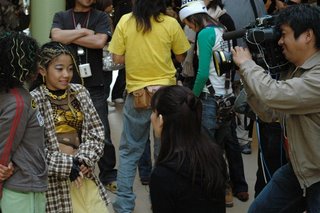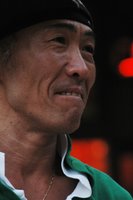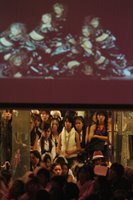This year saw the first ‘All Japan Super Kids Dance Contest’. On Sunday the grand final was held in the outdoor shopping area just down the road from my house in Kanayama, Nagoya. I went for a quick look, but then stayed for a few hours chatting to some of the dancers, the teachers and the passers by.

If you come to Japan you will see them. Not ninjas, dancers. They practice in schools, they practice in parks, and they practice on the street using glass fronted buildings for their studio mirror. I spoke to Hiro Sakuma, one of the competition judges and a member of the ‘Spartanic Rockers’ dance team who were the winners of the U.K B-boy championship 1998 (and are still going strong). He gave me a brief history of modern dance in Japan.
I spoke to Hiro Sakuma, one of the competition judges and a member of the ‘Spartanic Rockers’ dance team who were the winners of the U.K B-boy championship 1998 (and are still going strong). He gave me a brief history of modern dance in Japan.
It began for many, he said, in the 1970’s and 80’s with the American music program ‘Soul Train’ that was aired in Japan. Hiro told me that he used to watch it when he was growing up and that it provided an inspiration for a new generation of dancers. What about the young generation of today? Hiro explained that until about 6 years ago, breakdance was still the most popular form, then Hip-hop and other related styles began to gain popularity until about 3 years ago when the dance craze hit the mainstream. Why it went mainstream is another story, but I imagine that the (instantly disposable) idols of the J-Pop industry have done their bit to popularize dance. Remember the boy bands of the early nineties? That sort of thing but with more glitter.
Why it went mainstream is another story, but I imagine that the (instantly disposable) idols of the J-Pop industry have done their bit to popularize dance. Remember the boy bands of the early nineties? That sort of thing but with more glitter. So now many people want to learn the new ‘non-classical’ forms of dance. I spoke briefly to an 59 year old lady (not in picture) who had been to see Janet Jackson in concert a few years back and last month signed up for the Hip-hop class at the local dance studio. She had come to the show to support her classmates. What about the younger dancers themselves?
So now many people want to learn the new ‘non-classical’ forms of dance. I spoke briefly to an 59 year old lady (not in picture) who had been to see Janet Jackson in concert a few years back and last month signed up for the Hip-hop class at the local dance studio. She had come to the show to support her classmates. What about the younger dancers themselves? I interrupted two girls during their rehearsal to ask them. Both age 15 and in their final year of Junior High School, they had traveled from Yokohama that morning. One told me that she wants to be a professional dancer, the other that she wants to be a dance teacher. Not at all different to the dreams of many girls of the same age in the U.K. Younger kids that I asked just told me that it was fun.
I interrupted two girls during their rehearsal to ask them. Both age 15 and in their final year of Junior High School, they had traveled from Yokohama that morning. One told me that she wants to be a professional dancer, the other that she wants to be a dance teacher. Not at all different to the dreams of many girls of the same age in the U.K. Younger kids that I asked just told me that it was fun.
So now this very free style of dance has broken like a tsunami upon the shores of Japanese culture. I asked Hiro about the place of the more traditional forms of Japanese culture such as Kabuki in modern Japan, he told me quite simply that this is not Kabuki’s time. It’s the time of the ‘Ao Zora Kyoushitsu’, the open air classroom. The message is ‘just go out and do it’ (and yes, Nike were one of the main sponsors of the event)
So who won the competition?
I have no idea. The cat needed feeding and the shopping just wouldn’t wait. Time will tell if this dance craze has ‘got legs’, but for the moment I don’t see it slacking off.
No comments:
Post a Comment